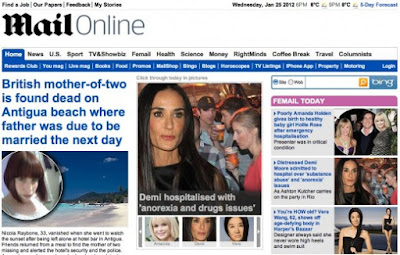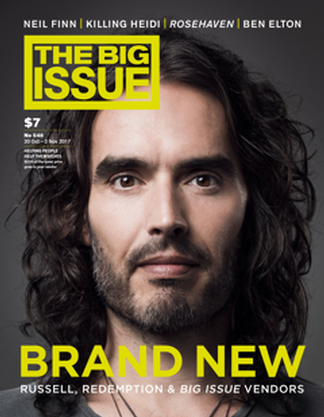AN EVOLVING MEDIA PRODUCT
In the twenty-first century, technology is forever becoming more popular, reaching much wider audiences than ever before. Nearly all industries now run completely online, with the idea of print in the past. The Independent newspaper stopped printing entirely in March 2016, claiming that the use of the modern day online idea would be "sustainable and profitable". Since The Independent's evolution from print to online, other newspaper companies, such as The Daily Mail and The Guardian, have increased their use of online publishing...
The Daily Mail
http://www.dailymail.co.uk/home/index.html
The online version of The Mail is an easy way to access all the top news stories instantly; unlike its print partner where readers have to wait until the following day, almost creating a day-long delay on the headlines. On the webpage there are multiple tabs across the top of the screen, for example, sport, health and money, allowing readers to access the news they are interested in without having to flick through the other stories. Similarly, an available search bar also allows readers to find specific news stories quickly, as well as being able to look back on older stories that aren't necessarily on the 'front page'.
E.g.
When looking into top headlines on the online editions, it is clear that The Mail Online presents all their stories with the same simple outlook as they do in print. As well as this, it is also clear that the political ideologies of the online edition stays the same. Down the right-hand-side of the website there are further stories, all focusing on the same 'celebrity' topic. These stories have a undermining and practically sexist approach, objectifying mostly women or the sake of a cheap headline. For instance, one headline reads "'Your pins are smoking hot!' Leggy Holly Willoughby sends fans wild as she bares a little too much while dancing in silky yellow skirt."
Furthermore, The Daily Mail also commonly uses civilian found information, whereas other companies would prefer to use information coming from a more trusted sources. This unreliability of sources helps to add to the simple demeanour of the headlines.
Though a similarity that both print and online have is the plugs, these advertisements helping to fund the companies. Though online editions are able to target audience individuals by using information stored online about their interests, and then targeting the adverts shown to these interests. This works well for both the newspaper and the company being advertised as they are being put out their to customers who are interested in similar brands to theirs. This specific identification of the audience is another positive of online editions other print. And hence, more readers are beginning to view their news in non-traditional ways.
The Guardian
https://www.theguardian.com/uk
The Guardian's online addition uses the same conventions and values as in their print edition, covering similar stories with the same viewpoints. Though it is clear that the online edition of The Guardian can show further stories with more information, as the capacity is much greater compared to the restricting ways of print newspapers. In print editions, the writers are given a set space in which they can cover a story; hence information is often very brief compared to what is available online.
Another positive of the online edition, is the tabs which the reader can easily access at the top of the home screen. These include, sport, culture, business and travel. Again, this is another aspect which the print edition cannot supply; readers are able to filter what stories they are interested in. Similarly, print editions don't allow for these interactions - a search bar is also available on The Guardian's online edition. This allows readers to search for recent headlines or to search back into the archives for past headlines, which are still stored on the website.
The Guardian online also includes useful aspects, such as the weather - local to where the reader is. This can be seen in the image below, at the top right-hand-side of the website. As well as this the online version gives the reader access to breaking news, headlines which have just been released. This live updating means that the stories are always up to date, keeping readers informed with what events have occurred 24/7. Whereas in print, the news stories are almost a day behind, as any publishing worthy stories which occur in the day won't be print until the following morning.
I personally feel that factors like these are what makes the online publications much more 'modern day friendly'; with each added aspect of the online versions made to make the life of modern day information seekers much easier.
The Daily Mail
http://www.dailymail.co.uk/home/index.html
The online version of The Mail is an easy way to access all the top news stories instantly; unlike its print partner where readers have to wait until the following day, almost creating a day-long delay on the headlines. On the webpage there are multiple tabs across the top of the screen, for example, sport, health and money, allowing readers to access the news they are interested in without having to flick through the other stories. Similarly, an available search bar also allows readers to find specific news stories quickly, as well as being able to look back on older stories that aren't necessarily on the 'front page'.
E.g.
When looking into top headlines on the online editions, it is clear that The Mail Online presents all their stories with the same simple outlook as they do in print. As well as this, it is also clear that the political ideologies of the online edition stays the same. Down the right-hand-side of the website there are further stories, all focusing on the same 'celebrity' topic. These stories have a undermining and practically sexist approach, objectifying mostly women or the sake of a cheap headline. For instance, one headline reads "'Your pins are smoking hot!' Leggy Holly Willoughby sends fans wild as she bares a little too much while dancing in silky yellow skirt."
Furthermore, The Daily Mail also commonly uses civilian found information, whereas other companies would prefer to use information coming from a more trusted sources. This unreliability of sources helps to add to the simple demeanour of the headlines.
Another major difference between the print edition and online, is the use of videos within articles. When going onto the home page of The Mail Online, there are videos playing along side the top headlines. These help to give a much more clear image to the reader, where sometimes a picture doesn't quite fit. This greater use of interactivity with readers is also magnified by the use of polls for example, with readers being able to vote on maters seen within the headlines. This is another way in which the online editions are able to gain reader interest by including stats later on in other headlines and adding specific themes of articles, voted on by The Mail Online readers.
The amount of information given is also usually greater than what is available in a print edition. This is due to the space available, with physical newspapers being restricted to how much room a story can cover, whereas the online version can give unlimited information.
The Guardian
https://www.theguardian.com/uk
The Guardian's online addition uses the same conventions and values as in their print edition, covering similar stories with the same viewpoints. Though it is clear that the online edition of The Guardian can show further stories with more information, as the capacity is much greater compared to the restricting ways of print newspapers. In print editions, the writers are given a set space in which they can cover a story; hence information is often very brief compared to what is available online.
Another positive of the online edition, is the tabs which the reader can easily access at the top of the home screen. These include, sport, culture, business and travel. Again, this is another aspect which the print edition cannot supply; readers are able to filter what stories they are interested in. Similarly, print editions don't allow for these interactions - a search bar is also available on The Guardian's online edition. This allows readers to search for recent headlines or to search back into the archives for past headlines, which are still stored on the website.
The Guardian online also includes useful aspects, such as the weather - local to where the reader is. This can be seen in the image below, at the top right-hand-side of the website. As well as this the online version gives the reader access to breaking news, headlines which have just been released. This live updating means that the stories are always up to date, keeping readers informed with what events have occurred 24/7. Whereas in print, the news stories are almost a day behind, as any publishing worthy stories which occur in the day won't be print until the following morning.
I personally feel that factors like these are what makes the online publications much more 'modern day friendly'; with each added aspect of the online versions made to make the life of modern day information seekers much easier.
The political ideologies which are presented in the online edition of The Guardian are the same to which are written in the print edition. Though the readership may differ slightly, even though the values remain the same between the print and online. This difference in readership may be more split between generations rather than political views; the older generations are more likely to be buying the print version, as this was traditionally how they would have got their news. Whereas the younger and working generations may be more inclined to subscribe to the online version as their lives revolve around the online world. Also, especially for the working generation, the online edition of The Guardian may be more accessible if they are commuting for work or don't have the time to sit down each day and read a physical newspaper.
The Guardian online will still continue to make profit for the company, as the plugs which pop up when looking at the website are paying to be shown to readers. This works well for both the advertising companies and The Guardian as these plugs are able to adapt to individuals on their own devices; the plugs will be of businesses or companies which readers are interested in.



Comments
Post a Comment